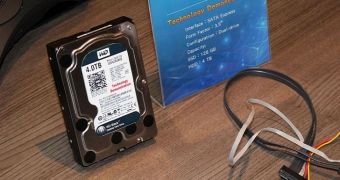PCI Express solid-state drives were first released in order to be the “face” of high-capacity SSDs, in a sense, because no other types of SSDs could even come close to the capacity limit of hard drives. Now, HDDs themselves are adopting the PCI Express technology, though not the form factor.
This has been coming ever since the first PCI Express SSD was made. Maybe before even that. Not that anyone has actually come out and said it.
There probably just wasn't a reason for them until now. After all, while high capacity was definitely a great asset for PCI Express SSDs, the speed was even more impressive, exceeding 1 GB/s almost from the get-go.
In comparison, HDDs can't really make the best of the SATA III interface, let alone the bandwidth of PCI Express.
You can see it in how SATA III HDDs read/write at around 300 MB/s and 145 MB/s (though the fastest is a WD unit with 401 MB/s read speed), even though SATA III allows for 600 MB/s.
We suppose that means that even the best SandForce SSDs don't use SATA III fully (they're limited to 550-560 MB/s), but the amount they fall short by is significantly lower.
Nevertheless, new interfaces allow for new storage device part arrangements and connections, and WD took advantage of that when it finally brought HDDs to the PCI Express interface.
So here we are, welcoming the first PCI Express HDD ever, one that does not bear a name because it is only a prototype.
Alas, as much as we'd like the novelty of it being a PCI Express add-in card, it definitely isn't one. Instead, it's a regular 3.5-inch drive that uses the new SATA Express interface.
SATA Express is a sort of middle ground between SATA and PCI Express, using a combination of both to increase the bandwidth of SATA ports/cables from 6 Gbps to 12 Gbps.
Advancing the SATA standard normally, without PCIe, would have taken more years than the consortium overseeing the technology would have been willing to wait. Only some Intel 9-Series chipset motherboards support it at this point for that matter.
The new prototype HDD can reach 695 MB/s, as shown in a sequential test at Computex 2014, a trade show taking place in Taipei, Taiwan.
That's only 95 MB/s above the limit of SATA III, so it's not that amazing in the grand scheme of things. Still, Western Digital gets a couple of accolades for the effort, even though a case could be made for the prototype not being an HDD at all.
You see, in addition to the platters that provide 4 TB storage space, the newcomer has 128 GB SSD storage too, for cache. It's more an HHD (hybrid HDD) than a real HDD. We can take is as a confirmation that magnetic storage really has reached its speed limit, and is relying on NAND Flash more and more for any new feats. It kind of implies that SSDs will replace them sooner rather than later. No wonder Seagate bought LSI, the premier maker of SSD controllers.

 14 DAY TRIAL //
14 DAY TRIAL //